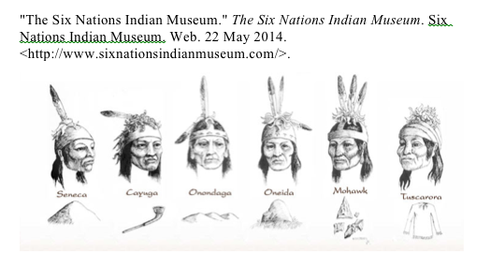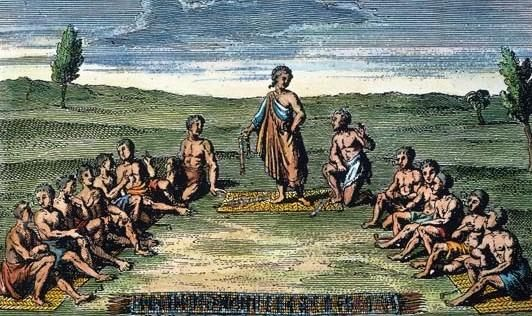When the Founders met in 1787 to create the U.S. Constitution, there were no contemporary democracies in Europe from which they could draw inspiration.
The only forms of government they had encountered were those of the Native American tribes. Of particular interest was the Iroquois Confederacy, who had already formed a multi-state government that ensures individual governance and freedoms.
The structure of the Confederacy represented five Tribes: Mohawk, Onondaga, Cayuga, Oneida and Seneca and was federal in nature, operating under The Great Law of Peace, a doctrine of 117 codicils where individual tribes handled their own affairs but came together to solve issues of common importance.
The founders were impressed by how the Iroquois legislated their affairs and shortly thereafter, they drafted the U.S. Constitution echoing the Great Law of Peace.
Historians agree the Iroquois wielded a major influence in the writings of the U.S. Constitution.
Mohican Chief Hendrick Theyanoguin, Mayor Abraham Yates, Jr., and Benjamin Franklin at the Albany Conference, 1754. (Illustration by John Kahionhes Fadden)
Before the Congressional Congress, leaders of the Confederacy attended the Albany Congress in 1754, where Benjamin Franklin was impressed by the Great Law of Peace and wrote what’s known as the Albany Plan of Union.
It advocated for the colonies to improve security and better defend themselves from foreign powers. In 1776, during the drafting of the Declaration of Independence, the Continental Congress in Philadelphia invited the Iroquois to make an address, where they were well received by the patriots.

In 1988, Congress passed a resolution formally acknowledging the influence of the Iroquois Confederacy on the U.S. Constitution. It reads, “The confederation of the original 13 colonies into one republic was influenced by the political system developed by the Iroquois Confederacy, as were many of the democratic principles incorporated into the constitution itself.”
In addition, the resolution stated, “the continuing government-to-government relationship between Indian tribes and the United States established in the Constitution,” which reaffirmed the legitimacy and sovereignty of Native nations and their governments.
About the Iroquois Confederacy
The Iroquois Confederacy dates back several centuries, to when the Great Peacemaker founded it by uniting five nations: Mohawk, Onondaga, Cayuga, Oneida and Seneca. In 1722, the Tuscarora nation joined the Iroquois, also known as the Haudenosaunee.
They were known during the colonial years to the French as the Iroquois League, and later as the Iroquois Confederacy.

The English called them the Five (later Six) Nations. Today, each of the tribes who comprise the Confederacy administer their own affairs and have independent tribal councils.
The Six Nations Iroquois Cultural Center provides for the viewing of 3000-plus artifacts, and features story telling lectures, and a gift shop adorned with Mohawk baskets, beadwork, books, t-shirts, silver jewelry, and acrylic paintings.
Astronomy and Mythology in Native American Culture
Before the age of global positioning systems or compasses, people looked to the stars to find their way. And before civilizations knew what stars were, people formed their own beliefs about their significance. In North America, indigenous tribes had differing ideas about what the stars meant, some believing that the night sky had spiritual meaning, and some attributing human-like qualities to the twinkling objects.
Archaeoastronomy is the study of how people of the past understood the stars and the sky, however this broadly applies to all ancient cultures.
The Mayans, Celts, and Egyptians alike all had their own methods for tracking the movement of the stars and heavenly bodies, but all of these cultures have the common belief that the phenomenon above their heads was somehow larger and greater than they were.
As such, the vast majority of ancient cultures associated the origins of everything, including the sky, moon, sun and earth with some form of mythology related to the stars. Astronomy played in an important role in early Native American cultures, serving as the basis for governance, agricultural practices and more.
And studying the stars also caused tribes to theorize about the beginning of life in the universe.
The Pawnee’s Guiding Principles
Polaris
The Skidi band of the Pawnee Indians referred to a ring of stars in the sky as “The Council of Chiefs.” The Pawnee believed the circle represented their governance style of elders holding council to resolve important matters.
This constellation was paramount to the way the Pawnee interacted daily as well as their religious beliefs. They used the stars to set agricultural patterns and embody their own societal values.
The Council of Chiefs was connected to their “Chief Star,” what is now referred to as Polaris, which represented their primary god Tirawahat.
They built their lodges with openings at the top – not only to allow smoke to escape from warming fires inside, but to allow a clear view of the “Council” stars. Today, those stars are known as the Corona Borealis.
The Anasazi
The Crab Nebula

In New Mexico, researchers found a cave painting that appears to depict a supernova explosion; the orientation of a crescent moon and stars indicate that the art may represent the Crab Nebula, formed in 1054 A.D. by supernova.
The Anasazi way of life remains somewhat of a mystery, but researchers found that the tribe built a solar observatory, suggesting that the sky was extremely important to the Anasazi way of life.
Navajo Creation of the Sky
A Navajo legend describes the Four Worlds that had no sun and the Fifth World, which represents Earth. According to the legend, the first people of the Fifth World were given four lights but were dissatisfied with the amount of light they had on Earth.
After many attempts to satisfy the people, the First Woman created the sun to bring warmth and light to the land, and the moon to provide coolness and moisture.
These were crafted from quartz, and, when there were bits of quartz that were left behind by the carving, they were tossed into the sky to make stars.
Hopi Blue Star
Like the Navajo, the Hopi believe there were worlds before this one. The modern era is believed to be the Fourth World, and each world that came before this one ended with the appearance of “the blue star.” In carvings created by the Hopi in the American Southwest, it seems what they saw may have led them to a belief in aliens, a belief that certainly retains a place in the culture of the U.S. to this day.
The divisions between Native American cultures were not unlike the divisions between the societies of today, so few myths extend beyond a single tribe.
The Iroquois Confederacy
The Iroquois are a group of American Indians from the modern-day northeastern United States and Canada. The word “Iroquois” is a French word, derived from a Huron word meaning “black snakes.”
They are also known officially as the “Haudenosaunee” and were also called the Six Nations by the English. Haudenosaunee can be translated to “People of the Longhouse.”
According to oral history, five nations banded together over 1,000 years ago to form a union. The five nations were the Mohawk, Cayuga, Seneca, Oneida and Onondaga. In 1722, the Tuscarora joined the union making the confederacy Six Nations.
A Council of Chiefs served as the Iroquois governing authority, however, the Six Nations function under the Great Law of Peace, an oral constitution that was first created sometime around 1142 and was later written on wampum belts.
The Iroquois Confederacy established that each nation should handle their own affairs. The Great Law of Peace is a unique representational form of government, with the people in the clans having say in what information is passed upward. Legend has it that Benjamin Franklin used many aspects of the Iroquois system in the development of America’s government.
The Iroquois are considered a matrilineal society because descent is passed through the mother, rather than the father. Both men and women have equal roles in the social, political and economic life of the community.
The balance of the gender roles makes the society unique. For example, children of either sex are affiliated with their mother’s clan.
The Haudenosaunee grew a variety of vegetables, such as corn, beans, and squash. Hunting and fishing contributed to part of the food they ate. They also grew tobacco that was used for ceremonial and medicinal purposes.
The men and boys usually hunted for deer, bear and small mammals. Although hunting was accomplished by bow and arrow, many also used and guns they traded Europeans for.
The Iroquois lived in villages with long wooden buildings called “longhouses.” Families would live together in the structures with extended family members. The Haudenosaunee viewed the concept of the longhouse like six families living under one roof, with each nation representing a family.
The Iroquois Nations could be described as similar to a large longhouse that extends from where the sun rises in the east, to where it sets in the west. the earth is the floor of this longhouse and the sky is considered the roof. In this great longhouse, the Mohawk nation are the keeper of the eastern door. The Seneca is the keeper of the western door.
The Onondagas in the middle are the keepers of the central fire. Together these three are referred to as the elder brothers and they represent half of the longhouse families.
The Cayuga, Oneida, and Tuscarora nations are the younger brothers and they represent the other families that complete the house.
Today, longhouses still exist on some Haudenosaunee reservations and are used for ceremonial purposes.
